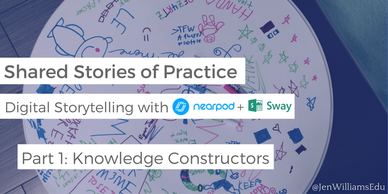 Through exploration and discovery, teachers are finding ways to use innovative digital pathways to share stories of practice and experience. As learners of today oftentimes visualize the world through nonlinear and hypertext frameworks, digital storytelling offers highly developed and multimodal forms of communication that allow students to reimagine learning and view shared stories as cohesive and interconnected constructions of expression. Literacies, aesthetics, and advanced practices associated with digital storytelling have the potential to positively impact the communicative landscape of our classrooms. With a focus on sharing the stories of pedagogy and of our world, we as educators can harness the power of digital narratives of practice to together transform learning and teaching in our classrooms. As the first post in a three part series of discovery and reflection, we are able to see into education of today through the lens of a teacher, a student, and an educational technology learning manager--all working to create pathways for the construction of knowledge for students. Through the power of Nearpod and Sway digital storytelling, themes of practice emerge. In these stories of learning, immersive spaces, explored passions, and authentic connections were each drivers for change. Though the pathways were unique, each brought a story of students empowered as knowledge constructors. Immersive Spaces Learning spaces of our modern classrooms have transformed to emphasize learner-centered instruction and seamless integrations of digital technologies. Immersed in supportive physical and virtual environments, students are encouraged to create and explore through processes of design thinking, inquiry, and investigation. As a 4th-6th grade special education teacher at Puesta del Sol Elementary in California, Nicholas Clayton structures his instruction around lessons and tools that promote knowledge construction. From Nearpod VRs Virtual Reality Field Trips to building of virtual worlds in Minecraft and Animal Jam to creating collaborative virtual spaces, Nicholas brings students on “educational adventures” to worlds they understand. For him, “students must have an outlet for their voices and be able to tell about their learning from a language they know.” In immersive spaces of the classroom, access and agency is within reach of the learner and the voices of all students can be inspired. Explored Passions Teachers in classrooms of today are finding ways for students to become the storytellers and builders of their learning paths. Through project-based learning and practices of personalized inquiry, students are provided space and time to thoughtfully develop passions into actionable plans for implementation and execution. These students, engaged in the process of following in passion projects, are analyzing problems of global significance and finding solutions to impact local and world communities. As a middle years student, Karishma Bhagani was challenged to not only identify a question for exploring, but also a question on a subject for which she was personally connected. In her journey to developing a working low-cost water purification system, Karishma was faced with countless challenges and failures. However, with freedom to fail and grow and the encouragement of her teachers and parents, she found that with perseverance and grit and the fuel of passion, she was able to ultimately reach the point of having a viable prototype. Today, as a student at New York University, Karishma is continuing her mission to bring clean water to communities across the world through her Matone de Chiwit organization. As teachers, these are the stories that fuel us--stories of educational practices that support students to take risks and follow in their dreams. For us, these are those moments that can ignite true change, and in the words of Karishma, are the drops that can create a million ripples. Authentic Connections We as teachers are in a constant search for ways to support our students as constructors of knowledge. Supported in immersive environments and engaged in projects that follow in their passions, they have opportunities to develop sincere connections to content to ultimately deepen levels of learning. Meaningful contexts and authentic audiences can propel learning forward and add richness to the learning experience for students in our schools. As an advocate for student voice and integration of technology in instruction, Zac Leonard of Lecanto Middle School works to provide students with real world situations in learning. With purposeful uses of social media and access to global audiences, Zac connects students to the world through stories of literature, history, and technology. He believes that “digital storytelling is just the next iteration of humanity’s need to share stories.” In classrooms like Zac’s, new ideas can take flight and connections to learning can be realized. Join us next week for Part 2: Students as Innovative Designers. Also, we welcome you to join the conversation and share your classroom stories and Nearpod+Sway experiences on social media with the hashtag #sharedstories.
0 Comments
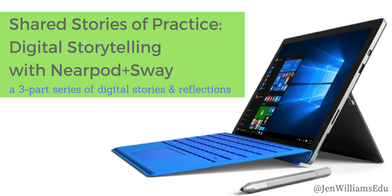 By Jennifer Williams In a charged and ignited movement to connect students to learning through inquiry and shared experience, teachers are engaging learners in interactive lessons through use of digital storytelling. Digital storytelling combines the traditional art of shared personal narratives with rich multimedia, such as graphics, images, audio, video, and text. Through a process of thoughtfully and systematically combining multiple modes of expression, teachers can design digital stories to enhance instruction across all content areas and grade levels. With digital stories, instruction can move beyond a basic goal of simply obtaining knowledge by allowing learning to deepen to levels of application, integration, and creation.Nearpod and Sway are two advanced digital creation tools that each provide a balance of structure and creative freedom for users to explore and create cohesive stories. With these interactive, multimedia presentation tools, teachers can use digital stories to capture and share the aesthetic beauty of human experience and diverse perspectives found within our world. Nearpod+Sway As an instructional tool, Nearpod offers an interactive and engaging platform for teachers to create personalized lessons and digital stories by seamlessly adding slides, images, videos, audio, and web links. Nearpod presentations offered as digital stories can be further developed by adding immersive virtual reality experiences, interactive “Draw It” activities, and collaborative response features, such as polls and open-ended questions. Now, teachers can enhance presentations and digital stories even more with the new integration of Microsoft Sway. Sway offers fully customizable canvases for creation of multimedia digital stories. By leveraging the power of combining these two digital storytelling tools in instructional practice and in learning, teachers have limitless opportunities for creating developed narratives and meaningful digital artifacts. Embedding Sways into Nearpod presentations is as simple as 1, 2, 3: Step 1: While creating a Nearpod lesson, simply select Add Slide, Add Content, and then you will see the Add Sway option. Step 2: From here, you will be able to embed a Sway digital story. Nearpod offers a curated collection of beautiful Nearpod-created presentations of stories of our world. Topics include Animals, Countries and Continents, Famous Landmarks, Historical Events, and Figures, and Seasons and Extreme Weather. Step 3: You can also embed your own personally created Sways into your Nearpod presentation. Current Office 365 account users can access their Sways or create new ones within the Nearpod platform. You can also add the direct web link for your Sway presentation by selecting Add Web Content from the main content creation menu. Once your Sway is selected and added, you are ready to publish and share your Nearpod+Sway digital story experience with a global audience. If Sways are new for you, click here to learn more about Getting Started with Sway. You can also check out this step-by-step video to learn more: Nearpod+Sway Digital Stories from our Classrooms:
A 3-Part Series on Shared Stories of Pedagogical Practice Shared stories of pedagogical practice from classrooms can be powerful messages with the ability to positively impact instruction in schools across the world. Teachers as storytellers can share the narratives of teaching and together can work to reimagine the educational landscape for today and for the future. With a dedicated focus on inquiry and engagement, in this 3-part series we will follow the digital stories of nine individuals in their journeys to each transform the educational experience as told through their personal digital narratives. Join as we examine themes and trends in practice, uncover pathways to engagement, and amplify voices beyond the walls of schools through a month long series using the power of Nearpod and Sway digital stories. Part 1: Students as Knowledge Constructors Part 2: Students as Innovative Designers Part 3: Students as Global Collaborators Also, we welcome you to join the conversation and share your classroom stories or Nearpod+Sway experiences on social media with the hashtag #sharedstories. Inspired by #OneSong, my #PLN, and the song Renegades by the incredible X Ambassadors.
I have always had an interesting relationship with rules. As a child, I often sought out rule-based systems, however would quickly find myself working to escape them, or perhaps more accurately put, go beyond them. As a teacher, I found myself compelled to follow each set rule precisely; loyal to a cause, always aiming to do “right” and stay the “course.” The rulebooks within my life offered sanctuary and direction, standards by which I could measure success. They also stirred alive within me a desire to find the unforeseen “loophole.” Alternative paths that led to the unknown. Boundless and bound living together playfully. Boundless, yet bound. This past year, equipped with passion and experience, I set out to make a new path. Not one that was traveled more or less, but one that had never been traveled. When faced with any decision, I decided I would trust in my instinct with a conviction that I had not before had. One good step would lead to another, and that next good step would lead to one ahead. For me, the concept of #goodbringsgood would be a guiding message to develop a path of positive growth and direction. As a connected educator, this year brought the most extraordinary friendships and experiences. Good brings good became a journey and a destination. I learned that working for the future and living in the moment for me can and should co-exist. As the year concluded, reflecting on the months and days and those moments, I realized that with all the steps I had taken over the year, I was only just at the trailhead on the course on which I was set to travel. So, here I am. My shoes laced up. My gear packed. Ready. But, where does this path lead? As an educator, I believe in education with every part of me. I am honored to be surrounded by a network of inspiring thought leaders that are pushing the boundaries in our profession and making measurable gains towards progress, innovation, and change. Together, I see a charged force that is ignited and readied for the journey. More and more, I see leaders stepping out. Determined and resolute. Admirably purposeful. Eager to make a difference. Looking to a set of rules in a system and continuing to strive for more. A coalition of educators all ready and willing to make it their life’s work to not only get it “right,” but ready to make it “right.” For so long, the term “renegade” brought for me thoughts of a mutineer or a rebel ready to break rules and fight against them. Me, a person afraid of breaking rules. Could it be conceivable and also acceptable to question the very system that created and in turn was enforcing the rules? Perhaps, with a shift in perspective. What if together as educators we could break ground on a new design for education inspired by hope? Confident, courageous, unwavering. Ready to stand together to change the narrative of a renegade from an outlaw to a valiant pioneer forging a new path. This year I am ready. Ready to stay true to my rule of #goodbringsgood. Ready to take steps one at a time and bravely look at established systems through a fresh lens. Ready to boldly create a new path based on a map with an entirely new set of rules that encourage the bound to be boundless. Go forth and have no fear. It’s our time to make a move. Let’s begin. Each day, there are countless opportunities for teachers to share their voices. And, many do. Through sharing within blog posts, professional development sessions, and discussions on social media forums such as Twitter chats, educators find platforms to connect and learn. For me, Twitter chats are spaces to not only grow as an educator, but they are also places that inspire my voice as an individual. In recent weeks, I was impacted in such a special way by a simple invitation, and I found that a "call to join" can have powerful and long-lasting effects. The evening started out like many. Getting my own children to bed, tidying up the house, and retreating to my computer to check in on messages before reading. After reviewing emails and reading several shared articles, one Tweet in my notifications particularly stood out. In a lot of ways, this tweet was similar to many that I send and receive in a day. A notification of a chat or of a relevant post of interest. But, in one distinct way, this message was different. I always take notice of any messages sent by Carol Varsalona. As a like-minded member of my PLN, Carol is a treasured mentor and voice of positive inspiration. In this message, Carol was inviting me over to the chat she was in. A personal invitation to join. Though I received the message well into the chat hour, and though I had not scheduled to allot time that evening to commit myself to chats, and though I was unsure of even the topic, I felt compelled to join. Because, as you see, Carol personally asked me to come. And, this instantly ignited my excitement to be a part of the experience! That evening it didn’t matter that I jumped into a chat that was well under way or that I was joining in with educators from a different state from my own. I was warmly and instantly welcomed into the group. Immediately, after introducing myself in the chat, I was engaged and a part of the discussion. Feeling a little bit transparent, I decided to respond to a tweet with an openness I don’t typically command in chats. As someone wrote about finding the time to blog, I admitted that this was an area of challenge for me. Within moments, others joined in and shared that this too was an area of struggle for them in their lives. With only minutes left in the chat, our small bonded group, with a newly formed allegiance to make time and commit to each other, pledged to together make time to share our voices through blogging and support each other in the process. In less than a quarter of an hour, we created a community. Over the following days, members of our new community, each part of our named #TribeofBloggers, shared posts and projected their voices—some for the very first time! This all leading up to my post here today.
As I reflected on the impact that one small invitation to join had on me as a teacher and a connected educator, I started to consider moments in the classroom. Do students feel this same way in a classroom? How do students feel a sense of belonging? What small, simple moments can amplify the quiet or silent voices in our schools--the students that are on the fringe and feeling just outside a conversation? Is it an unspoken truth that students are members of a community simply by being part of the classroom or are personal invitations to join needed? I hope to work a little harder to make all students (and educators) feel included and part of the conversation. By sending out more calls to participate, I will look to ensure that each voice is included and represented. Just as Carol sent a special invitation addressed right to me, it is my goal to send out personal messages to students within a class community and to create contexts that empower voices; helping all to find their own paths of sharing and their own tribes to take on the journey of learning! This blog post is dedicated to Carol Varsalona, the welcoming educators of #NYEdChat, and to our #TribeofBloggers Ben Dickson, Donald Gately, Angela Stockman, Terry Stoufer, Natalie Krayenvenger, and Sara Holm! Looking forward to our second posts in our series coming up in the next two weeks!
Today, with increased focus on use of technology for expression and content creation, traditional definitions of reading, writing, and communication are being redefined to include new digital literacies. Multimodal literacies--the integration of multiple forms of communication and expression--have the potential to transform the meaning of a student’s work. With these digital tools, students can demonstrate their ability to understand, interpret, and discuss by using multiple texts across multiple contexts and multiple modes. Faced with detailed and complex texts across all areas of the curriculum, students must master the ability to read and write like scientists, historians, mathematicians, and world citizens. In an increasingly global and technologically based world that prioritizes effective communication skills, these skills all are critical for the future success of an individual.
Digital tools allow for a transformation of the learning experience and can expand the scope of knowledge in education. These new technologies allow students to engage in all forms of communication—reading, writing, speaking, and listening, and alone have the power to encourage inquiry, critical analysis, and content area literacy. However, when digital tools are combined, the possibilities for learning can be exponential. Here are some ways to combine digital literacy tools in the classroom. Periscope + Nearpod • Periscope allows users to broadcast live video with their phones or other devices to connect to the world https://www.periscope.tv • Nearpod allows users to create interactive presentations that are fun and engaging; learning can be assessed in real-time https://www.nearpod.com • Perisciope + Nearpod: You can use interactive format of Periscope to connect to the world in a discussion with global classrooms, students, and educators. In your "scope," share your Nearpod presentation and viewers can follow along on their own devices. With interactive features, such as polls, multiple choice questions, and 360Cities Virtual Field Trips, you can have meaningful interactions and real time feedback throughout your presentation. Interested in learning how to combine these two great digital tools? Check out this Nearpod presentation as we take you step-by-step through the process! Also, be sure to use Katch.Me to store your "scope" for replaying in the future! Skype + Padlet • Skype offers free videoconferencing for classrooms to connect and chat online. www.skype.com • Padlet provides a virtual cork board for organizing practically anything, including photos, videos, links, documents, and notes! www.padlet.com • Skype + Padlet: The possibilities are endless when combining Skype and Padlet during collaboration sessions. For instance, during a Mystery Skype session, students could work together on a Padlet to place clues and answers to help find the location of the other class. Other ideas to use Skype and Padlet together is for student collaboration on a global project, teacher sharing during a videoconferenced professional development session, and student back channeling during a Skype session with an industry expert, notable author, or global leader. Here is an example of a Padlet created during an EdCamp Global session entitled "Go Digital" with Stephan Hughes. In this session, he shared from his location in Rio de Janeiro with an international audience of educators. Teachers and classrooms from around the world were able to add comments and questions throughout his session, and also before and after. http://padlet.com/watstefsmaydov/GoDigital YouTube + EdPuzzle • YouTube hosts user-generated videos. www.youtube.com • EdPuzzle allow teachers to customize videos for use in the classroom www.edpuzzle.com • YouTube + EdPuzzle: One of my favorite new digital tools is EdPuzzle. EdPuzzle allows teachers to customize videos from the Internet, such as YouTube videos, with features such as Crop (to cut portions of a video), Audio Track (overlay audio over the entire clip), Audio Notes (insert comments to extend the concepts and ideas), and Quiz (add open ended questions, multiple choice questions, and comments to the video clip to assess learning and increase engagement). Here is an example where I took a YouTube video of a podcast lecture with Eoin Lenihan of Germany that is 38 min and 26 seconds and cut it into a clip that is now just over 2 minutes. I add audio notes to interact with you as an audience member and include several questions. You will see how the possibilities for use in the classroom are great when combining EdPuzzle with YouTube for learning! Sharpening pencils to a perfect point. Checking the spelling of each student’s name to ensure every one is correct. Carefully coloring in the lines of a welcome sign to invite students to their new classroom; a classroom that for students will be a place all new where memories will be made, friendships developed, and life lessons learned. In these beginning weeks of the school year, teachers take care to consider small details; details that that when considered in sum create the experience of “school” in a child’s world. With intentional and thoughtful focus on the needs of each individual student, teachers set out to create a culture of their class. And, in the earliest hours of the first day of the new school year, teachers and students together begin to form the community of their classroom.
In recent days, though faced with the hustle and bustle of back-to-school, I was inspired to reflect on the impact of teaching small. A video launched with the Remind #teachsmall campaign truly demonstrated for me so beautifully the lasting effects of dedicating efforts to the little things when building a culture with students: http://bit.ly/teachsmall_blog Soon, I was considering how so many of today’s teachers are working to extend this community to include a critical member of the learning team: the parent! In small, yet meaningful ways, classroom teachers are beginning the year by fostering #teachsmall moments to welcome parents into the conversation of “school” and learning. Here are some ideas for finding ways to bring #teachsmall to the parents of your classroom. Back-to-School “Parent-Led” Conferences Often, first conversations with parents are procedural. Instead of waiting for back-to-school nights, start your relationship with your new parents during Week 1 by offering time to parents to schedule and join you for a 20-minute “Parent-Led Conference.” As opposed to traditional conferences where teachers lead the discussion, encourage parents to share any thoughts, dreams, and concerns for their child. Questions such as “What motivates your child?” and “How can I best support your child’s life passions?” can allow teachers to learn about children through the lens of a parent. More, it is a small way teachers can show that they sincerely care about the interests and needs of the family. Learn the Names of Your Classroom Parents A name is a special thing. Teachers understand the importance of referring to students by name and constantly seek out ways to showcase the names of students both in class discussions and also in the classroom environment. By taking time to learn and use parent names, teachers demonstrate that they are invested in parents and that they are treasured members of the classroom community. Proclaim a Vision of “Parents as Partners” “Parents as Partners.” Make it your parent/teacher motto. Brand it. Market it. And represent it. Sign messages and notes home as “Your School Partner.” Thank parents personally for their partnership each time you see them. Dedicate a bulletin board to parents and post announcements or exciting updates that are just for them! “Parents as Partners!” Simple, yet so significant! Sharing of Stories A common feature of a community is the sharing of stories. Celebrate cultures, interests, or unique talents of parents by inviting them to join for a class discussion. Interested parents that are unable to visit in person can join via videoconferencing with tools such as Skype or Google Hangout. Another idea: develop a Mystery Reader program; guest parents can surprise students and join to share their favorite read aloud story. Finally, consider organizing a parent/student/teacher book club to meet throughout the year. This can demonstrate the importance of reading together and sharing together. Share Messages of Small Moments Each day in a classroom is filled with special, small moments of greatness. Noticing that a student always stops to smell the flowers, witnessing a much needed learning breakthrough, seeing an apprehensive student bravely try something new for the first time. Teachers have front row seats for so many small, defining, "star of the show" moments such as these. Showcase, share the positive, and send a message to parents by using the Remind tool. “Just wanted to share…” messages can brighten days and help parents be a part of the community of a class. Because, as we all know, moments like these are too good not to share and celebrate! As classroom communities of teachers, students, and parents embark on a new school year, we celebrate the moments that are small, yet defining and impactful. The difference-making little things that are extraordinary…and anything but ordinary. Be sure to share your #teachsmall stories on Twitter and Facebook, and in your schools. To read more about this special initiative and Remind as a tool for connecting the community of your classroom, visit: http://bit.ly/teachsmall_blog. 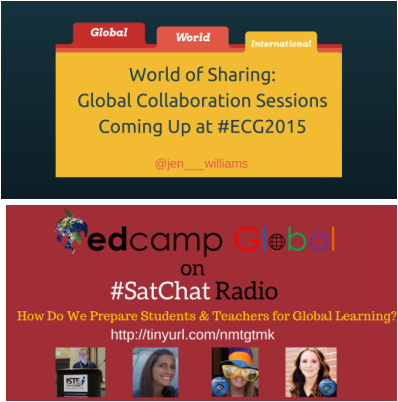 With increased focus on global collaboration in our world, educators are leading the way by connecting with international classrooms. Each day in schools of the world, teachers seek out ways to share perspectives, develop meaningful relationships, and grow together as professionals. Through innovative methods of networking and connection, educators are using collaborative tools, such as Google Hangout, Twitter, Voxer, and Periscope, to engage in impactful discussions. This week, educators from around the world together will be sharing their voices in the EdCamp Global virtual conference. Recently, I had the pleasure of joining my fellow EdCamp Global planning team members, Jaime Donally and Cassie Reeder as we discussed the topic of Global Collaboration with Billy Krakower on the BAM Radio Network podcast #SatChat Radio. Together, we explored the question of how do we prepare students and teachers for global learning. With education going global, we acknowledged in our discussion that professional development also is changing, and even more so, evolving at rapid rates to allow for the open sharing of perspectives from educators of the world. EdCamp Global, an international, 24-hour virtual “unconference” is an example of professional development that truly embodies this notion. Starting with a simple idea, EdCamp Global has quickly turned from a concept to a movement with a widespread global following. Currently, there are over 1,450 attendees registered that represent 33 countries. With over 170 sessions offered, there is something for anyone in education that may be looking to learn or share. Scheduled topics cover areas such as Apps for Learning, Digital Citizenship, Maker Movement, and Google for Education. Sessions centered on global collaboration seem to top the lists of high interest for both sharing and learning. As the mission of EdCamp always encourages participants to move freely in and out of sessions by using the “rule of two feet,” the attendees of EdCamp Global that kicks off this Friday at 8pm CTZ will definitely have to use the “rule of the mouse” to ensure that they can share their voices in all of these amazing sessions on connecting students with the world. In efforts to “not miss a global beat,” I scanned the schedule and started noting all the sessions I could find that raise the topic of connecting students internationally. I asked a few EdCamp Global facilitators to get our “global collaboration” gears turning with some conversation previews! Making the Case for Global Competence in Your Community Facilitator: Heather Singmaster Twitter Chat: #globaled 8pm CTZ You know that to be successful in the 21st century, students need to be globally competent. But does the rest of your community agree? This session will explore ways to make the case and advocate for global education with key constituents such as parents, business, administrators, and other community members. In this Twitter chat session, participants will look together at different arguments and can share examples of what has worked – and what hasn’t! Go Digitally Global Facilitator: Stephan Hughes Twitter Chat: #GoDigital 9pm CTZ Web 2.0 tools abound inasmuch as the resistance among teachers to use them in the classroom for diverse reasons. Understanding the rationale and acquiring the mindset of a digital pedagogy will set teachers on their way to make their own edu-digital footprint so they can help their students hone their 21st-century skills. Join Stephan Hughes, an extraordinary language consultant from Rio de Janeiro for this globally connected Twitter chat! Go global, and #GoDigital! Globally Connected Classrooms Facilitator: Brian Host Google Hangout 11pm CTZ This session, facilitated by EduHero Brian Host, will offer educators an insight into some of the best practices in connecting educators and classrooms globally. In this Google Hangout session, best teaching practices in global collaboration will be highlighted, including class blogs, reflective professional blogs, video conferencing (forms: expert in the room, author guests, virtual excursions and mystery locations), global projects, the use of social media. Brian will also be joined by Craig Kemp, Bev Ladd, Jena Ball, Marty Keltz, Brett Salakas and leading educators Sunny Thakral, Alex Le Long and Viv Hall. This "Crossing the Seven Seas" #ECG2015 session is not to miss! Engaging Student Voice: Top Tech Tools for Global Collaboration Facilitators: Jennifer Williams & Fran Siracusa Twitter Chat: #GlobalLearning 10am CTZ Let's explore ways to collaborate globally and engage student voice with tech tools. In this fast-paced, Twitter chat session, participants will discuss how to empower students to share knowledge, experience, life passions, and individual perspectives through use of digital literacies. Qs will guide the sharing of stories of success in the classroom and will offer practical examples of digital tools and instructional practices for inspiring students to be creators of content and agents of change in the world. Four Seasons of Collaboration Facilitator: Billy Krakower Google Hangout 12pm CTZ In this Google Hangout session, Billy Krakower, moderator of #SatChat Radio and the #SatChat Twitter chat, will facilitate a discussion on the “Four Seasons of Global Collaboration.” In this session, participants will explore different ways to connect students of the world! Classroom Makeover: Learning Spaces that Foster Global Collaboration Facilitator: Jennifer Williams & Fran Siracusa Periscope Chat: @jen___williams paired with Nearpod 2pm CTZ Interactive Periscope/Nearpod session that demonstrates the importance of using the learning space of the classroom to promote collaboration, innovation, and exploration. Five easy-to-implement ideas help to transform rooms to spaces that promote global collaboration and seamless integration of technology. Come for fun and inspiration! Engaging Students in the Globally Connected Classroom Facilitator: Craig Kemp Twitter Chat: #globaled 6pm CTZ In this one-off Twitter chat, the hour will begin with an exploration of the term “global classroom.” Over the course of the hour, participants will discuss ways to specifically connect classrooms to the world and ideas on how to use global connections to make an impactful difference in the world today. For more information on this highly anticipated ECG Twitter Chat, check out Craig’s blog post at http://mrkempnz.com/2015/07/globaled-a-one-off-twitter-chat-spectacular.html. Listing of #ECG2015 Sessions Discussing Global Collaboration:  What does it mean to be a Florida connected educator? Today, I was honored to join Tanya Avrith, Lisa Dabbs, and Tammy Neil in in Remind’s first ever #RCEChat Webinar to explore this question and discuss our personal journeys as connected educators. With opportunities for networked collaboration at virtually the fingertips of every educator in the state of Florida, the potential for connection is limitless. For me, being a connected educator is truly about personalizing my network and nurturing the bonds that have been created. My journey to becoming a connected Florida educator has been powerful; the experience transformational; connections developing into friendships and then friendships into bonds to last a lifetime. Quite literally, with plenty of warm sunshine and lots of beautiful, blue water, the state of Florida is fertile ground for planting the seeds of connection. Supportive networks fervently and selflessly charge themselves with helping new-to-Twitter educators to connect with the acts of sharing and supporting ultimately represent defining features of connected educators. If you are looking for ways to develop connections in Florida, here are some ideas to grow as a connected educator in the sunshine state. 1. Twitter Chats Twitter instantly appealed to me as a professional because I was able to customize my Professional Learning Network. I sought out educators that brought a sincere, genuine, and positive voice to the conversation of education. More, I was drawn to teachers that offered student-focused solutions to challenges instead of placing focus on problems. With like-minded individuals, I quickly was able to engage in conversations that positively changed me as a teacher and, more as a person. Twitter chats allowed for expanded and focused discussions on topics that were personally significant in my life. If you are a Florida educator new to Twitter, here are three not-to-miss chats:
2. Expand Conversations Twitter is a wonderful entry point to ignite ideas and spark discussions. There are other amazing tools that allow for conversations to be expanded and further explored. Check out these interactive and innovative connection tools:
3. Connect at Conferences With a focus on networking, learning, and growing, Florida conferences offer wonderful opportunities to connect personally with educators and innovators. Check out these great Florida conferences and be sure to follow each of them on Twitter:
4. Focus on the Relationships As we concluded in our discussion and webinar today, it was clear that we all were certain that the key to being a connected educator is to keep focus on developing, supporting, and nurturing connections. Relationships are key, and any thriving PLN is built around people first, not places, programs, or tools. With a focus on relationships, unconferences and informal meetups have become movements of empowering educators to share their choices in professional growth. With Remind #CoffeeEdu connected chats and EdCamps all over the state, Florida educators are changing the model of professional development and encouraging the voice of the teacher. To find your local Florida Edcamp, visit http://edcamp.wikispaces.com. All Florida educators are invited and welcomed to EdCamp Tampa Bay coming up on October 10, 2015! We would love to have you join in our fun. To register, visit www.edcamptampabay.com. Many thanks to Tanya, Lisa, Tammy, and Remind!  Vision. It allows us to outline a path for which to follow. It not only reflects the culture of an organization through statements of goals and aspirations, but it provides the “how” and the “why” to place purpose and framework. In recent months as I have worked to prepare for EdCamp Tampa Bay, the local EdCamp in my area that I together with Fran Siracusa have worked to develop, I have often looked to the vision and the mission of the EdCamp Foundation as a guiding force. Though simply stated, I believe the words so clearly substantiate the original and thoughtful intentions of the founding members. Vision of EdCamp We are all self-directed learners, developing and sharing our expertise with the world. Mission of EdCamp We build and support a community of empowered learners. This past week, I was honored to be a part of the nationwide EdCamp event, EdCamp Leadership, that brought educational leaders together in multiple areas across the United States to discuss topics of critical significance that are affecting classrooms and educators today. EdCamp Leadership Melbourne, the Florida event organized by Susan Bearden (@s_bearden) and Cathy Koos (@ckoos1) and held at Holy Trinity Episcopal Academy, was an extraordinary day of learning and sharing. And true to the foresight of the EdCamp pioneers, the day was indeed one of great vision. “We are all self-directed learners.” For me, one of the best parts of EdCamp is the creation of the “board.” As an organically developed schedule of sessions, the board embodies the EdCamp vision in that we all, for one day, become somewhat of conference coordinators. I am fascinated by EdCamp session boards and always watch with anticipation as they develop. Educators directing their own learning—essentially modeling what I hope is happening in classrooms---students part of the process of inquiry and at the center in their search for knowledge. At EdCamp Leadership, something quite simple, yet profound happened that I believe is the essence of EdCamp. That morning, as I left the introduction hour, I quickly took a picture of the session board and headed off to the first sessions. During one morning session, I noticed a teacher next to me, a teacher I had never met in person, creating a sketchnote of the conversation. I was immediately thrilled as learning to sketchnote has been on my “personal learning bucket list” for the year. As I followed along with the session and the hashtag #edcampldrFL on Twitter, I noticed that my neighboring teacher had posted a picture of her sketchnote as the session continued. I introduced myself and learned that her name was Lali DeRosier (@LabCoatTeacher) and, by her Twitter history of images, I could see that she was an avid and talented sketchnoter. I quickly retweeted and then replied asking her if she had a sketchnote session on the board for the day. What happened next was pure EdCamp "magic” in my mind. We met after the session, and she said that though she had thought to put it up, she had decided not to. Soonafter, she visited the board, found an opening, and added her session…Sketchnoting 101! At Lali’s standing-room-only session, I created my first-of-many sketchnotes. The creation of this session happened in the moment and based on interest and engagement. “We are all self-directed learners.” Vision! “We are all developing and sharing our expertise with the world.” I love Periscope, and as an early adopter, I knew instantly that the possibilities were distinctive and endless for use in education. For the second session of the day, I was thrilled to watch the power of Periscope play out for the world to see. As facilitator Tanya Spillane (@TanyaSpillane) started to demonstrate Periscope and to walk everyone through the basics, Jerry Blumengarten (@cybraryman1) jumped right in to make his first “Scope.” Very quickly, Jerry had 10, 20, 50, 70 people from around the world tuning in on Periscope for the #edcampldrFL Periscope session! They were asking questions and engaging as participants. Next (and as Jerry continued his “scope” video), Tammy Neil (@TG_Neil) shared ways to connect with Voxer. Within minutes, a mutual EduPal that was watching on the Scope, Voxed Tammy and, they together yet divided by distance demonstrated the interactive nature of the Voxer tool. It was one connected conversation between session participants that were there in person, on Periscope, and on Voxer. “We are all developing and sharing our expertise with the world.” Vision! “We build and support a community of empowered learners.” As the overarching purpose of EdCamp, I believe this mission statement speaks of the vision the strongest. EdCamps offer inclusive learning and sharing moments that are transformational. So similar to the instant and deep bonds that we found as kids in our childhood summer camps, the relationships formed at EdCamps somehow create connections that continue and flourish. You become one united front. Empowered to have a voice and inspired to make a difference. Through sessions such as Twitter 101 with Jerrry Blumengarten, Tammy Neil, and Jerry Swiatek (@jswiatek) that encourage teachers to build and develop Professional Learning Networks, to conversations that seem to resonate and stay with you for days, such as Rebranding Digital Citizenship with Tanya Avrith (@TanyaAvrith), EdCamps truly “build and support community of empowered learners.” EdCamp Leader, I believe, allowed each of us time, space, and moments to consider the “hows” and the “whys” of our individual worlds, and left us each to ask “What is our own vision for the future of education?” As we each work to develop the hows and the whys, I am thankful for opportunities to connect with visionary leaders of our world of education. 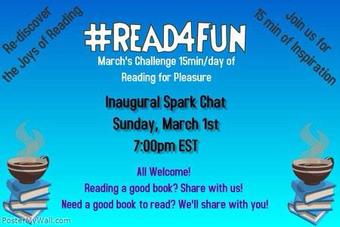 Four years ago, as I started in my doctoral program, I was ready and prepared to make some life sacrifices. Quickly, sleep was replaced by studying, social events were replaced by writing, and words in my life, such as relax and unwind, were replaced by words like quantitative and qualitative. I immersed myself in research and was ignited by the way one study would lead me to five more. However, along the way and without notice, my reading identity had changed and reading for pleasure was lost. Though I am always reading, I realized recently that something was missing. So, I started to reflect and quickly found that it was the connection that I so missed. Connection to characters, connection to stories, connection to other readers. Book clubs just don’t seem to exist in my current world of academic research and educational studies. So, as I prepared for my 40th birthday coming up next month in March, I decided that I needed to find a way to do both. Research is part of me now and will be a constant in my life. It energizes me and keeps me questioning and searching for knowledge. Therefore, I needed to find a way and find the time to re-connect to my identity as a reader that I used to know; one that devoured books and stayed up late because the pages just seemed to continue turning without me even realizing. What happened next was magical and truly exemplifies the power of reading and the power of connection! And it all started with a tweet! This past weekend, in efforts to inspire my “re-connected to reading” self to books, I sent out a tweet to my PLC on Twitter asking for great book recommendations. Soon after, the amazing Sean Gaillard @smgaillard responded with a suggestion. This sparked a connection with Connie Rockow @crockow8 and Lena Rockwood @Dr_LMR. Connection turned to conversation. Conversation turned to collaboration. And collaboration turned to creation. Within hours, #Read4Fun was formed! Together, the four of us were energized and eager—each motivated to share our excitement surrounding books! We tweeted to each other from the grocery story, the beach (sorry northern friends---yes, the weather here in Florida was nice enough for a beach day yesterday), and then from bookstores. We gathered books for our reading lists and started to tell others. Very soon, more people started sharing similar stories of how they, too, missed the readers they were years ago. One day later, #Read4Fun, a concept that was built on both books and connection, had organically developed. Something that started simply with a birthday wish and a tweet was bringing me back to my reading self. And, don’t you know, I stayed up way too late last night--lost in a book with pages that just seemed to turn themselves into the early morning hours! Looking forward to our inaugural chat this Sunday at 7pm! |

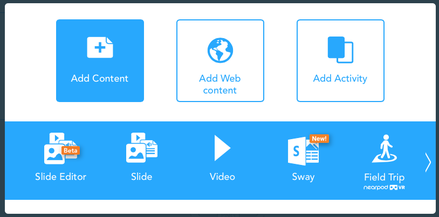






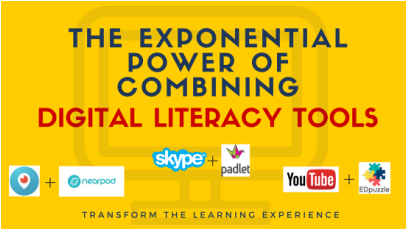
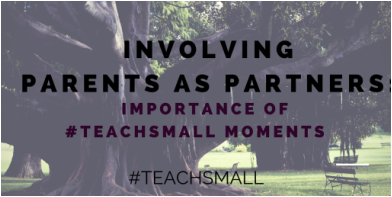

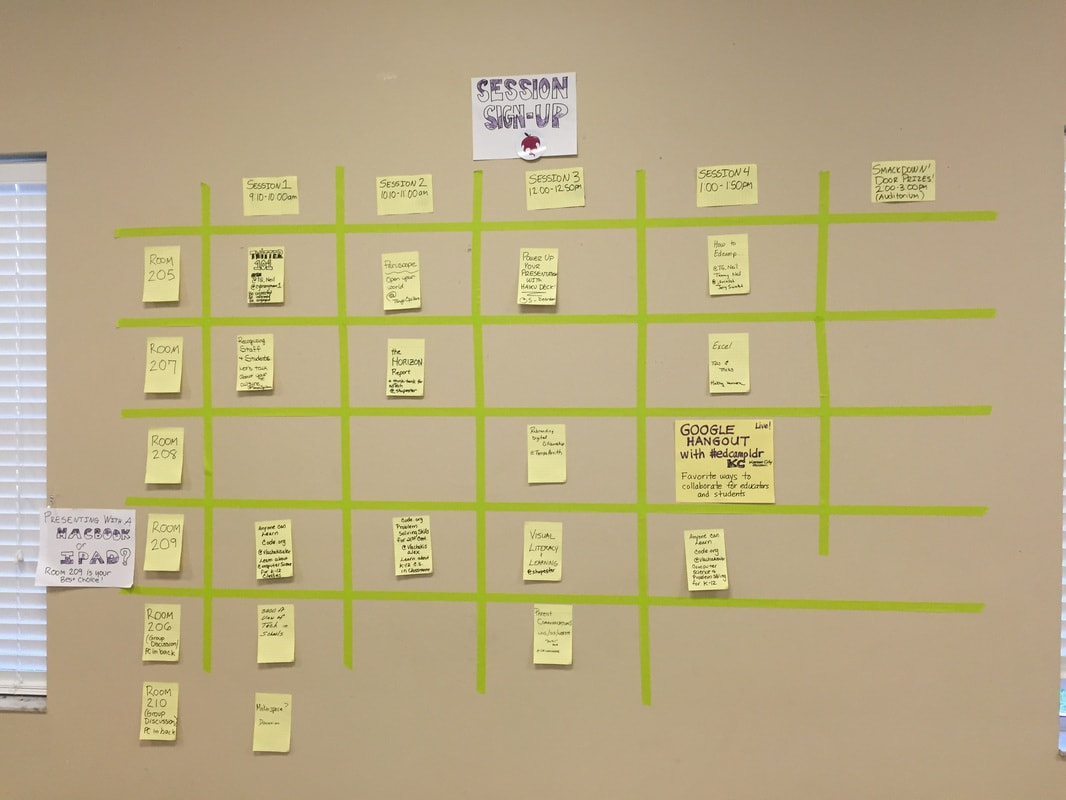

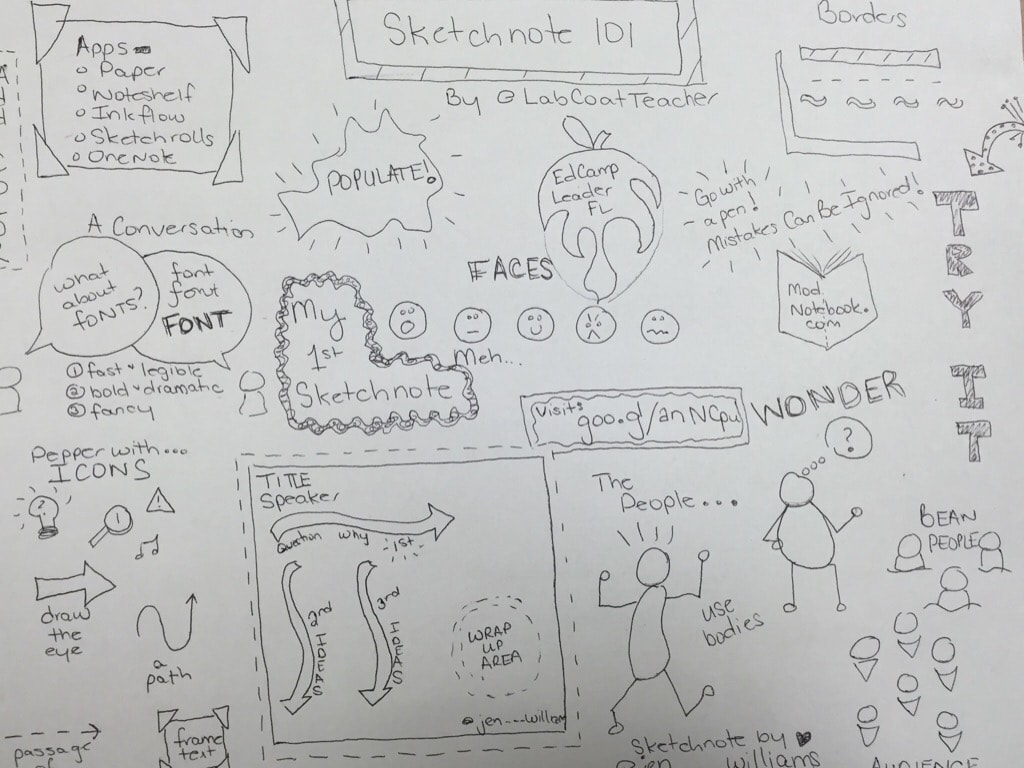
 RSS Feed
RSS Feed